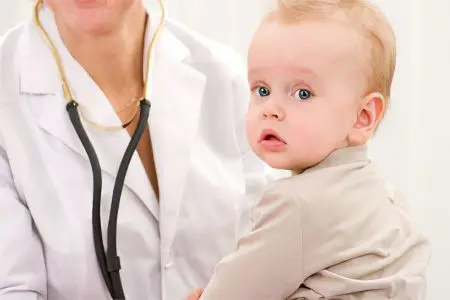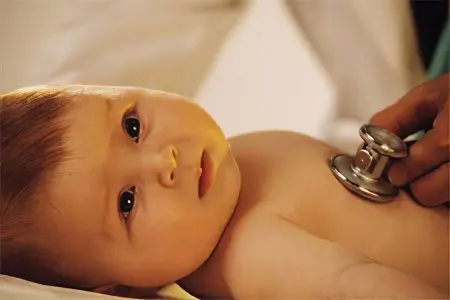Contents
This disease occurs in all age categories, but most often its various forms are found in pediatrics. If in adults and children who can eat foods that stimulate the growth of hemoglobin (pomegranate, apples, liver), the situation can be corrected by adjusting the diet, then the parents of an infant often do not know what to do.
Anemia – what is it and why is it dangerous in newborns?

With a low content of hemoglobin in the blood, which is a building material for red blood cells, anemia develops. Red blood cells, or erythrocytes, transport oxygen to all cells in the human body. Almost 98% of their composition is protein (globin) and iron.
The lack of this element in the body of newborns leads to a delay in the development of brain structures and severe immunodeficiency. At the first signs of anemia, you should immediately contact a pediatrician, since at the initial stage anemia can be corrected quite easily. The average and severe degree of this disease requires careful implementation of the recommendations of the pediatrician.
Cause of anemia in an infant

In the first 6 months of life, the child uses the iron reserves laid down in his body in the prenatal period. With a lack of iron in the diet of the baby, after this period, anemia develops. The consequences are even more difficult if a deficiency of a valuable trace element occurs in the perinatal period.
Causes of iron deficiency in the body of the fetus:
Deficiency of copper, folic acid, vitamin B12 in the body of a pregnant woman, additional medication is required;
bleeding during pregnancy;
Iron deficiency in the body of a woman who is expecting a child, to compensate for it, you need to adjust the diet, take drugs with a high content of trace elements;
Poor diet of a pregnant woman;
Anomalies in the development of the placenta;
Injury suffered during pregnancy;
premature birth;
Late ligation of the umbilical cord;
Rhesus conflict;
Infections transmitted by a woman during pregnancy.
That is why, for timely monitoring of the health of the pregnant woman and the fetus, it is important to register in the antenatal clinic on time. It is advisable to do this until the gestational age has reached 12 weeks. Cooperation with the gynecologist is very important throughout the gestational period.
What can cause acquired anemia in an infant?:
Use of an adapted milk formula;
Introduction to the diet of whole cow’s milk;
Bleeding against the background of an infectious disease;
Pathology of the gastrointestinal tract;
Burdened heredity;
lead intoxication;
upper respiratory infections;
Violations of the process of blood formation;
Disturbed diet of a nursing mother.
All of the above causes change the shape of red blood cells and their color, blood cells become lighter, acquire an oval shape.
Symptoms of anemia in newborns

In infants, anemia may not show any obvious signs. Only the results of a blood test can speak about the disease, when the hemoglobin content in them is below 110 units.
Symptoms of anemia, noticeable to the parents of the baby:
Restless sleep, daytime sleepiness;
Lethargy and capriciousness;
Desire to eat inedible objects (clay, sand, earth);
Complete lack of appetite;
hair loss, weak growth;
Spitting up for no reason;
Cracks in the corners of the lips;
Frequent colds;
Dyspeptic manifestations, disruption of the digestive tract;
Stomatitis;
Brittle nails;
Increased sweating.
If the child has similar symptoms, the doctor prescribes a general blood test. The norm of hemoglobin in a newborn child is 200 g / l, in a child up to six months – 100 g / l, over 6 months – 140 g / l.
If a child noticeably lags behind the norm in the results of the analysis, a pediatrician should be consulted.
Varieties of anemia in children under one year old

Slowed production of red blood cells or cessation of their production causes anemia in an infant.
Types of anemia in infants:
Anemia of premature babies – is fixed in each child who appeared ahead of time, it is determined even in the maternity hospital;
Iron deficiency or hypochromic – fixed in 80% of all cases;
Hemolytic – occurs when the Rh-conflict of mother and child, as well as when a pregnant woman is infected with toxoplasmosis, rubella, herpes;
Alimentary – is formed against the background of a monotonous diet, poor in vitamins and microelements;
Anemia due to infection – may be a symptom of pathology;
autoimmune – irregularly shaped erythrocytes with this type of anemia lead to oxygen starvation;
Anemia yaksha-gayema – characterized by an increase in the liver, hyperthermia, blanching of the skin, the appearance of shortness of breath and heart murmurs, a sharp decrease in hemoglobin, although the number of red blood cells remains within the normal range;
hypoplastic anemiawith a high mortality rate, and hemoblastosis (leukemia) – occurs due to the suppression of the activity of erythrocytes by leukocytes due to impaired immunity, or due to impaired synthesis of erythrocytes.
Degrees of anemia in infants

The severity of anemia in an infant is divided according to the level of hemoglobin and the concentration of red blood cells:
Mild degree. Laboratory indicators: erythrocytes – 3 million / l, hemoglobin – 90-110 g / l. The condition does not require treatment, it is corrected by introducing a more varied diet into the diet of a woman in a state of lactation. With transient anemia, the pediatrician monitors the condition of the child and prescribes special drugs for him.
Average degree. Laboratory indicators: erythrocytes – 2,5 – 3 million / l, hemoglobin – 70-90 g / l. With this degree of anemia, the child lags behind in his physical and mental development from the age norm, the work of the gastrointestinal tract and the cardiovascular system is disrupted. The child feels dizzy, short of breath, often suffers from colds and infectious diseases, children with anemia of this degree are usually lethargic and weak. This degree of pathology most often needs the supervision of a doctor in a hospital, treatment with iron preparations.
Heavy Degree. Laboratory indicators: erythrocytes – less than 2,5 million / l, hemoglobin – below 70 g / l. In infants with this degree of anemia, the kidneys and intestines, the hematopoietic system, the respiratory and circulatory systems are affected, and dystrophy appears.
Treatment of anemia in infants

Therapy of anemia is carried out only after a thorough diagnosis, identification of the type and form of the disease. If newborns or infants are diagnosed with “iron deficiency anemia of the 1st degree”, the correction of this condition can be carried out outside the hospital, only when changes are made to the baby’s diet and daily routine.
Comprehensive treatment – necessary measures:
Impact on the causes of anemia (replacement of milk formula, correction of the mother’s diet).
Taking vitamins and supplements with a high iron content, for better absorption, they are given between feedings, possibly mixed with fruit juice, although they are already available in the form of syrup.
Making changes in the diet, following a diet that includes buckwheat porridge, egg yolk, apple puree, liver, meat, cheese, fruit juices, vegetable puree, avoiding semolina, rice cereal, oatmeal.
Correction of the daily routine: long walks, massage, games with elements of physical education, gymnastics, extra sleep.
The minimum duration of treatment for anemia in an infant is 1 month or more.
At the birth of a child with hypoxia, prematurely, with large blood loss, he is given a mass with a high content of red blood cells (30%).
Therapy for anemia grade 2: prescribing drugs with a high iron content (Aktiferrin, Maltofer, Hemoferon), selected in accordance with the individual characteristics and needs of the baby. Most often they are available in the form of oil and water-soluble drops.
Therapy for anemia grade 3: when the hemoglobin level in an infant is below 70 g / l, an urgent blood transfusion is performed in a hospital.
The effectiveness of therapy in infants

Therapy of anemia in infants should be accompanied by a sparing regimen:
Frequent walks in the fresh air;
Temporary refusal to visit children’s preschool rooms;
Limitation of physical activity;
Correction of the diet, early introduction of complementary foods (earlier by 2-4 weeks).
After correcting these factors, treatment with medications is started. After 1-2 weeks of complex treatment, with full observance of all conditions, there is an increase in hemoglobin levels, an increase in reticulocytes. Hemoglobin can rise to normal within 3-5 weeks, and even after that, treatment should continue for at least 3 months.
The reason for the lack of positive dynamics after 3-4 weeks of treatment:
Incorrectly calculated dosage of an iron-containing drug;
Neoplasms and inflammation in history;
Infection with parasites;
Misdiagnosis;
Vitamin B deficiency12.
After analyzing the causes, the pediatrician corrects the therapy of the disease.
Low hemoglobin – School of Dr. Komarovsky:









